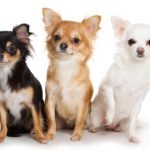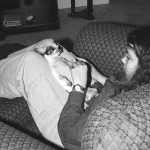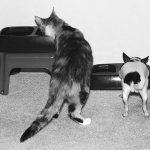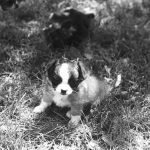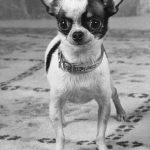In This Chapter
- Curbing your Chi’s crying and barking
- Continuing or correcting your housetraining
- Addressing behaviors such as humping and possessiveness
- Understanding and combating separation anxiety
Uh oh! Chief Chihuahua rules at your house. He growls when someone tries to sit in his chair, barks as loud and as long as he pleases, refuses to drop forbidden objects, guards his food with a vengeance, and sometimes even snaps to keep his spot on the bed. Obviously, a coup is long overdue. It’s time to overthrow your tiny tyrant and put policymaking back in the hands of the people — namely, you! With dogs, a benevolent dictatorship works best. First, elect yourself president for life. Then read this chapter. It helps you turn your tiny tyrant into a true friend for life.
Curing Your Crybaby
Most puppies whine and bark the first several times their owners confine them to rooms or crates. Whatever you do, don’t take your Chihuahua out of his place of confinement to stop the racket. That’s exactly what he wants, and doing so makes him feel rewarded for barking nonstop. Instead, wait until he’s silent for at least a minute; then you can go to him and let him out.
You can use some other tactics to squelch your Pepe’s complaints. Try them in the following order, moving on to the next one in line only if you need to:
1. The first few times you confine your Chi and leave him alone, try to put up with the noise for ten minutes without doing anything. Some dogs simply quit sounding off when they realize they’re dramatizing to an empty theater.
2. Play a radio softly near him. Music relaxes some dogs. Just be sure to keep both the radio and the cord out of his reach.
3. If he is still mouthing off, make a sudden loud noise from another room. You can stamp your foot or slap the wall. But be sure not to say anything. It’s better if he thinks that his own racket, not you, caused the noise. As soon as he whines again, make the noise again. Repeat as often as necessary.
4. From the room next to the one he’s confined in, bang two metal pots together. Do this once only every time he barks or whines.
5. Fill a spray bottle with plain water, and every time he makes a racket, walk in silently and squirt him one time, directly in the face. Then walk out again. When he’s quiet for a minute or two, go to him without the spray bottle and pet and praise him. Repeat as necessary. It won’t be necessary long! This is a last resort, because it’s physical and your dog sees you do it, unlike the loud noise, which you hope he thinks he caused.
Remember
Your Chihuahua should always have a safe chew toy and something to snuggle under when he’s confined. This will make him feel safe and may reduce his tendency to whine and cry.
Quieting Your Barker
Some Chihuahuas are noisy little dogs that seem to yip at the slightest provocations and mouth off nonstop when they want attention. Their tendency to vocalize makes them good watchdogs, so smart owners don’t want to completely turn off their tiny noisemakers. But frenzied barking for attention or when someone walks near the house gets old real fast.
Warning!
You want to scream when your barking dog drives you to distraction, but resist the urge. If you yell when your Chihuahua barks, he’ll think you’re joining in. Then the excitement of leading his best friend in a bark-a-long will egg him on all the more. Don’t get exasperated and pick him up, either. All that does is make him feel even braver. Why? Because in your arms he’s taller and protected by you.
The following sections explain what you can and should do in two specific situations: when your Chi barks at the door and barks for attention.
Mouthing off at the door
Your Chi needs to learn the command “Enough” (see Chapter
Establishing Good Behavior and Manners) so you can appreciate his warning bark when a stranger comes to the door but turn it off on command (see Figure 11-1). You can also use Enough to stop him from barking for attention (see the following section). If your Chi wasn’t taught to respond to Enough as a pup, try the spray bottle method I discuss in the previous section. It usually does the trick. In rare cases where it doesn’t, try the following:
1. Rather than plain water, pour a mixture of vinegar and water (a few drops of vinegar added to the water) into your spray bottle.
2. Have a friend ring the bell and/or knock on the door.
3. Let your Chi alert you (that’s a good thing) and then tell him “Enough,” firmly.
4. If the command doesn’t stop his tirade, make him think twice by spraying him in the mouth with the mixture.
Be as discreet as possible. It’s best if he thinks his tantrum, not you, caused the sour taste in his mouth.
Repeat if you have to, but whatever you do, don’t lose your temper.
Tip
One of the best ways to cure a Chihuahua that barks like crazy at the door is to set up situations in which friends bearing treats ring the bell. At the sound, put a leash on your dog, open the door, and invite the person in. Give the “Sit” command, and as soon as your dog shuts his mouth and sits, have the visitor give him a treat. This system may take several tries, but eventually your dog will figure out that the doorbell doesn’t signal the boogeydog!
Figure 11-1: Cricket guards the entrance to her motor home but quiets down on command.
Yapping for attention
If your Chi barks incessantly for attention, don’t give in and cuddle him; if you do, he’ll discover how to manipulate a petting session whenever he wants one. Instead, either ignore him or use the “Enough” command (see Chapter
Establishing Good Behavior and Manners) — reinforcing it, if necessary, with your spray bottle (one squirt only of plain water, directly in his face). Don’t let him see the shower coming. He should think he triggered it by barking after hearing the word Enough. (See the first section for more on using a spray bottle.)
Housetraining a Stubborn Chihuahua
Because so much of housetraining is up to the owner, let me ask you a few questions:
Did you clean up every mistake right away (without using ammonia or yelling at your dog)?
Did you praise your Chi every time he relieved himself in the right place?
Did you give him an opportunity to go potty as soon as you got up in the morning, every time you arrived home, as well as after every meal, nap, and play session (up to ten times a day when totaled)?
Be honest with yourself. If your routine is haphazard or you’re not taking out your dog often enough, it’s
you who are sabotaging housetraining. Get a crate, read Chapter
Establishing Good Behavior and Manners, and start over.
Maybe it isn’t your fault at all, however. If you did everything right and your Chi still leaves doggy-do on the carpet, keep the routine going but add the following. Also, check out the following sections, which explain different types of accidents. Knowledge is power!
– When you come home, don’t greet your Chi or give him any positive attention until after he eliminates in the proper place. Then praise the devil out of him.
– Learn to read your dog’s bathroom language. Most Chihuahuas (and other dogs) circle several times before squatting. If your dog starts circling, pick him up and head for the potty place. Then praise him for going there.
– Control his intake of water. Careful! Dehydration is dangerous! Give him free access to water during the day — especially with and after his meals and following activity — but take away his water dish about three hours before you go to bed.
If it’s hot in your house or if your Chi plays hard later in the evening, let him lap some ice cubes. That way he gets the liquid he needs without bloating himself.
– Crate your Chi when you go out without him — even for just a few minutes.
– When you’re home, keep your dog with you on lead until he’s reliably housebroken. That way he can’t sneak a whiz behind the sofa.
Tip
This technique also gives you a chance to catch him in the act. If you do, keep calm, tell him “No!” emphatically (without yelling), pick him up, and take him outside. Then tell him how wonderful he is for finishing the job in the right place.
Marking — it’s a macho thing
Male dogs have an instinct to mark their territory, for which they use (you guessed it) urine. It’s a macho thing. Dogs think their scent warns male dogs to stay away and attracts the ladies, but owners feel like bawling when their dogs lift their legs on table legs and bookcases.
Neutering provides the quickest cure. Otherwise, just keep your housetraining routine going, crate your Chi when you’re away, and be patient. Housebreaking an intact (unneutered) male Chihuahua is possible, but it takes longer.
Tip
Sometimes, just as you relax and congratulate yourself on your housetraining accomplishment, your dog reaches puberty, learns to lift his leg, and must be reminded of his manners. A few weeks of keeping him on lead in the house (so he’s always with you) and confining him when you’re away often is all it takes to put him back on schedule.
Submissive urination
When you come home, does your dog greet you happily but with a hint of shyness, while squatting and dribbling several drops of urine? That’s called submissive urination. Though often mistaken for a housetraining problem, this is really an anxiety problem and has nothing to do with housetraining at all. The tendency may be inherited, may be caused by harsh or too-frequent corrections, or even by abuse your Chihuahua suffered before you got him.
Between wolves in the wild, submissive urination means, “Hi boss. Sure hope I didn’t do anything to upset you, but if I did, I’m sorry.” Though it happens most often during a greeting, a dribble may also occur when you bend over him to pick him up or when you chastise him. The urination is a conditioned reflex to dominant treatment, and your Chi isn’t doing it on purpose. In fact, he doesn’t know he’s doing it at all.
Warning!
Never chastise your Chi for submissive urination, because that only makes it worse.
Tip
The easiest way to prevent a host of problems — including submissive urination, whining when confined, separation anxiety, and jumping — is to come and go without making a fuss. Long apologies before leaving and boisterous homecomings overstimulate many dogs, and excited dogs behave erratically.
Toss a treat for your Chi the instant you arrive home instead of bending over to pick him up. After he eats the treat, ignore him until he comes to you for attention. When he does, tickle under his chin or rub his chest (with your palm up) instead of reaching over his head or bending over him.
You also can teach him a few easy commands so he knows how to please you and earn praise. Then use a simple command, such as “Sit,” when you greet each other (see Chapter
Establishing Good Behavior and Manners). Now you’ve given him a positive way to express his devotion and earn your praise.
Remember
Compliments from you are what eventually break the submissive urination cycle. Being praised for a correct response builds confidence, and confidence is what a Chi needs to conquer submissive urination.
Reinforcing the “Drop It” Command
Your Chihuahua is a portable vacuum cleaner with the mouth muscles of Jaws, Jr., and he loves what he shouldn’t have. How can you get him to release forbidden objects without prying his tiny trap open? First, try taking him on a “shopping spree” (see Chapter
Establishing Good Behavior and Manners). If he still refuses to drop taboo booty, put a drop of Bitter Apple spray (available in pet stores) on your finger, and then slide your finger along his gum line as you give the “Drop It” or “Out” command (choose a command and use the same one every time). He’ll soon discover that it’s smart to let go. (The “Trading for treats” section later in this chapter offers yet another technique.)
Humping (How Humiliating!)
Oh no! Your Chihuahua just humped Aunt Amelia’s leg during the family reunion. Why does he do these nasty things? Rampaging male hormones are often to blame when he embarrasses you by humping someone’s leg or puts on a sex show with a throw pillow. Dogs don’t have sexual inhibitions like people do, so when the scent of a female in season wafts by and stimulates his libido, he tries to satisfy his frustrations with whatever is available. Because legs are close enough to the right height and width, many dogs mount them.
Remember
Neutering cures many males of mounting and relieves their frustrations, making them better pets in other ways as well. But if the humping is habitual, you may not notice a difference for a month or more after surgery.
Although neutering (see Chapter
Visiting the Vet) is the cure of choice, some people may not want to neuter their Chihuahuas because they plan to use them for showing and breeding. Because dogs that mount legs are also displaying dominance (the urge to be boss), dealing with that urge may break the habit (see the following section).
You soon recognize when your dog’s libido is becoming overactive. If he heads for a leg with that telltale vacant look in his eye, distract him by using a command such as “Sit” to stop him in his tracks. Keeping a shaker can handy also helps. (That’s an empty soda can with a few pennies in it and a piece of tape over the opening.) If your Chi still tries to attach himself to his favorite throw pillow or your spouse’s ankle, break his focus by tossing the can so it hits the floor near him (just don’t hit him).
These techniques (and those that follow) also cure females that are so dominant that they have a mounting habit.
Warning!
Don’t get angry with your dog to teach him who’s boss. All that does is teach him aggression. Withhold petting and praise until he earns it. Make him work for attention by obeying a command (such as Sit) or performing a trick (see Chapter Training Your Chi for Canine Events, Tricks, and for Show), and give him more exercise (see Chapter Chirobics: For Fitness and Fun).
Dealing with Dominance
If your Chihuahua has a tendency to be possessive, his behavior may extend beyond the food dish (see Chapter
Establishing Good Behavior and Manners for more). Some Chihuahuas (and other breeds) demand sole ownership of their favorite chairs, their end of the sofa, or even their snuggle spots on the bed. And when anyone tries to sit in
their spots, the resentful dogs snarl a warning and, in some cases, may even snap. Granted, Chihuahuas tend to be sassy — but surly is unacceptable.
Remember
You should never, ever be afraid of your dog. Not even for an instant. Don’t ignore or excuse threatening behavior because it ended quickly. If you do, next time your Chi’s threat will be even stronger. And yes, if he got away with growling at you once, there will be a next time.
Most Chihuahua owners react with surprise the first time their petite pooches growl a warning at them. They don’t realize that the growls (which, if unchecked, can escalate into snapping) only happened after their dogs established dominance over them in several subtle ways. For example, does your Chi badger you into petting him by pawing at you or nudging your hand? Do you sit where you did before you got him, or has he taken over your favorite corner of the sofa? Do you feed or give him treats when you want to or when he demands (or begs)?
If he’s already calling some of the shots, you’ve lost round one; it may be only a matter of time before he’s ready to test you at another level. Perhaps you’ll be in a rush to clean up before company arrives, so you reach for his food dish before he licks the last morsel. He goes rigid and stands over the dish with his eyes looking directly into yours. You shrug it off and say something like, “Okay, just hurry up and finish it.” You’ve just lost round two. When round three comes, it could be a growl. You now know there’s a problem, but you’ll probably think that he never did anything like that before.
Okay, now that you know what can happen, you can start preventing it immediately. The following sections show you how.
Tip
If possessiveness is becoming a problem, encourage other members of your household to make your Chi earn his rewards by obeying commands. Otherwise, he may learn to obey you but still challenge your spouse, for instance.
Possessive pup adjustment
The same techniques both prevent and cure possessiveness (but prevention is always the best policy). One of the best ways is to make your Chihuahua work for his food and privileges. If you haven’t taught him the basic commands in Chapter
Establishing Good Behavior and Manners, start now. If you did teach them, you’re ahead of the game. Use them in everyday life. “Sit” when your dog wants food. “Down” when your dog wants petting. “Come” when he wants a treat. Sit and “Stay” before you allow him up on the sofa. “Enough” when you’re tired of petting him and he paws you for more. You get the picture. At the first hint of possessiveness, make these acts privileges, not rights.
Tip
Establish dominance by inviting your Chi to sit beside you by saying “Come On Up” and patting the sofa when you say it. Then lift him up beside you if necessary. At the same time, teach him to “Get Down” by giving that command while pointing at the floor. He will figure out the signal if you place him on the floor every time you say it. Eventually, he’ll jump up and get down on command under his own steam.
Warning!
Young puppies can’t jump up on the sofa themselves and shouldn’Tip be allowed to jump down because they can damage their legs or shoulders. Using the cues Come On Up and Get Down before your puppy matures is a good idea, but place him on the furniture and always lift him down while he’s young.
Changing your attitude
Is possessiveness already a problem? You need to change your attitude as well. Instead of taking the path of least resistance, like backing away when your Chi growls (which teaches him that growling gets him what he wants), resolve to take command of the situation. Make him work for every bit of attention. Use the commands from Chapter
Establishing Good Behavior and Manners often, and give your dog affection and praise only for complying. If he growls when he’s on the bed, don’t allow him on the bed. The same applies to the sofa, chair, or wherever he displays dominance (see Figure 11-2). After several days of making him earn attention, you can let him share your chair again. But only on your terms — by invitation only — from now on. It could take months of not allowing him on your bed or chair before the behavior changes.
Don’t pity him because he has to go through this. You’re doing him a favor. When you train your Chihuahua and let him know how to please you, he becomes happier and more content. After all, he can relax. The household is in good hands — yours!
Figure 11-2: Possessive dogs defend “their” chairs, but Tiko hopes her owner will join her.
Dealing with hard cases
If your dog has been the boss for a long time and is serious about biting when you try to reform him with the tactics I describe here, don’t try to deal with him yourself anymore. A Chihuahua may be small but he can still do damage — especially if he snaps at your face. Instead, ask your veterinarian to recommend a professional trainer or behaviorist. The investment you make is worth it. A good pro puts your relationship back on the right track and teaches you how to maintain it.
Trading for treats
Some Chihuahuas become possessive over treasured objects — anything they have that you want to take from them, such as a pencil that fell off your desk. You can try to prevent possessiveness over objects by teaching your Chihuahua what “Out” means:
1. Get a small plastic container with a lid, break up a few of your dog’s favorite biscuits, and place them inside.
2. Shake the container, open it, and give him one treat.
Do that two or three times a day until the mere sound of the shake excites him.
3. Graduate to shaking the container while he gnaws on his favorite toy.
4. Say “Out,” give him a treat when he drops the toy, and walk away without touching the toy.
5. After several days of this, pick up the toy when you give him the treat, hold it for a second or two, and then put it down again.
Soon you’ll be able to get him to open his mouth and trade any object for a treat.
When the object is a taboo item, be sure to keep it after making the trade and then show your Chi his own chew toy. For an alternative method, often used for habitual offenders, see the section “Reinforcing the ‘Drop It’ Command” earlier in this chapter.
Home Alone and Feeling Frantic
Most mature dogs catch a nap when their owners leave the house, but some anxious dogs pitch a fit when they’re left home alone. They may chew on the carpet, shred the toilet paper, urinate, bark nonstop, or unleash any combination of destructive behaviors. You’re probably thinking, “poor owners,” but believe it or not, the destructive dogs are miserable, too. They have a problem called separation anxiety.
To better understand separation anxiety in dogs (see Figure 11-3), consider the phobias people have. Some people are afraid of heights, others are afraid of tight places, and still others are afraid of the water. Well, dogs are social creatures, and some of them are afraid of being alone. They panic, pure and simple, and then make noise or destroy stuff to release pent-up nervous energy.
The following sections help you understand the condition even more and provide some tips for alleviating your dog’s nerves.
Figure 11-3: Dogs hate to be left alone, but most eventually get used to it — within reason.
Adjusting your exits and entrances
Some dogs seem to be born with tendencies toward separation anxiety. Others develop it after a major change — the owner’s divorce or being given up for adoption. But a surprising number of dogs catch the problem from their owners. It goes something like this:
“Oh, poor poor Pepe. I’m leaving now. Are you gonna miss me? Are you? I’m gonna miss you. Poor sweetums. You’ll be all alone (kiss, kiss). Now you’ll be a good boy, won’t you? Give mama a kiss. That’s my boy. Poor baby. I’ll be back soon. I promise (kiss, kiss).”
And then the owner leaves.
Now, what does Pepe make of all this? He just got a lot of attention and sympathy and then his human left. Maybe she’s not coming back. Maybe he’ll never see her again. Maybe he’ll never see anyone ever again. No wonder he feels anxious!
Remember
The best way to prevent separation anxiety is to make your comings and goings low key. Ignore your Chihuahua for ten minutes before you leave and take him for granted when you return. Don’Tip make the mistake of thinking that your dog has human emotions. He doesn’t tear up the house out of spite because you left him alone. And he certainly doesn’t have fun doing it. He’s actually miserable. Separation anxiety is comparable to a person with claustrophobia getting stuck in an elevator. Your Chi needs help, not punishment.
The following section details what you can do for a dog that already suffers from the problem.
Alleviating the anxiety
Okay. You know your dog already has a problem with separation anxiety. Perhaps you could’ve prevented it, but no need to fret over that now. Just don’t set up your dog for another dreadful day of demolition. Instead, crate him comfortably when you leave the house (see Chapters
Welcome Home, Little Amigo and
Establishing Good Behavior and Manners for tips). In addition to keeping him out of trouble, being in his den may calm him. Yes, I know, that’Technical Stuff just a quick fix and doesn’t actually cure the problem. But it’s a start, and you’re keeping your dog out of trouble so he doesn’Tip sense your aggravation.
Now that you have the destruction under control, you can work on alleviating your Chi’s anxiety problem when he has the run of the house (or even a whole room). To do this, you must leave the house frequently for short periods of time. Eventually, that teaches him that comings and goings are unimportant because you always return. Here’s how to set up your scenarios:
1. Take Pepe outside to eliminate about ten minutes before you leave.
2. Turn on the radio and make sure two of his favorite toys are available.
3. Leave Pepe’s crate in its normal place with the door open so he can go inside if he wants to.
4. Don’t say goodbye or reassure Pepe in any way. In fact, don’t give him any attention at all for several minutes before you leave.
5. Leave, close the door behind you, and count to ten. Open the door, go inside, and ignore Pepe for a minute or two. Then tell him to “Sit” and praise him for obeying (see Chapter Establishing Good Behavior and Manners). 6. Gradually increase the amount of time before you come back in. Make progress slow at first. Take two weeks to go from ten seconds to ten minutes.
If you find a puddle or the beginning of any destruction, don’t call it to Pepe’s attention; make a mental note of how long you were gone. Next time, decrease the amount of time you stay away. Then gradually work your way back up.
With a lot of practice (and patience), you may be able to work your way up to spending a few hours away from home without your Chi having an anxiety attack. Unfortunately, this doesn’t work with every dog. If your dog doesn’t learn to accept separations, he may need professional help. Ask your vet for referral to a behaviorist (if you’re lucky, there may be a board-certified veterinary behaviorist in your area). The solution will include desensitization work and may include a temporary prescription of a drug to help keep your dog calm as he completes his desensitization program.
Tip
If your dog used to suffer from separation anxiety but overcame it, be sure to put him in a reputable boarding kennel when you go on vacation instead of hiring a dogwalker or housesitter. Otherwise, leaving home and not returning for a week or more could make him regress.
Warning!
Now that you know what to do, here’s what you shouldn’t do: If your Chihuahua becomes a demolition demon when home alone, the worst — yes, the absolute worst — thing you can do is punish him when you get back. This simply gives him additional anxiety. Instead of being scared only when you leave, he’ll be terrified of your return, too. That means double trouble.
by Jacqueline O’Neil




